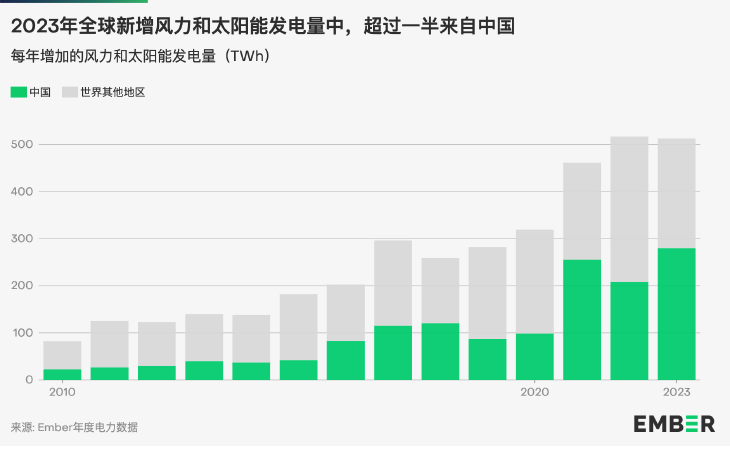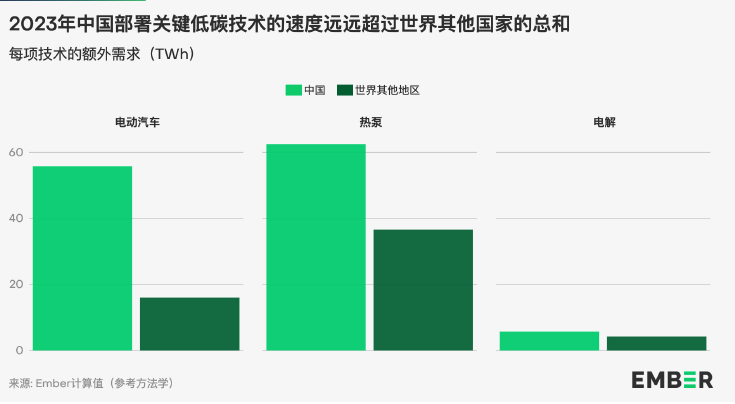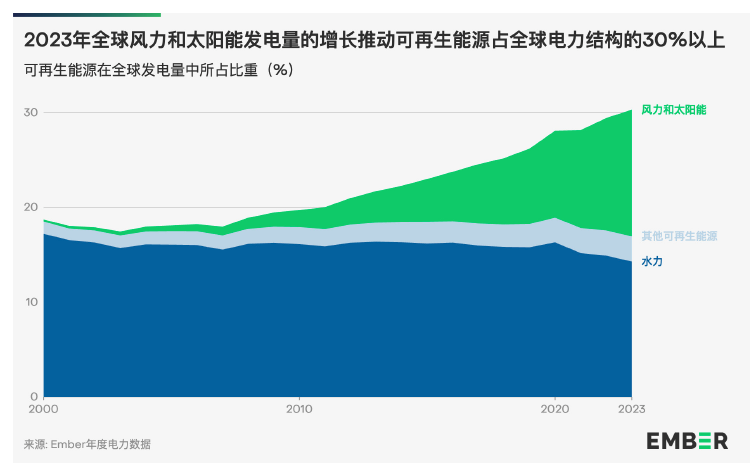A turning point in the history of the earth's energy: 30% of the world's electricity comes from renewable energy, and China has made a huge contribution
Global energy development is at a critical crossroads.
On May 8, according to the latest report by Ember, a global energy think tank, in 2023, thanks to the growth of solar and wind power generation, renewable energy will account for an unprecedented 30% of global electricity generation. 2023 could be a marked turning point for the power sector's carbon emissions to peak.
"The future of renewable energy is already here. Solar energy, in particular, is developing faster than anyone could have imagined. Emissions from the power sector are likely to peak in 2023 – a major turning point in energy history. Dave Jones, Ember's head of global insights, said.
Yang Muyi, senior power policy analyst at Ember, told The Paper that at present, most wind and solar power generation is concentrated in China and developed economies. In particular, China has made a significant contribution to the growth of global wind and solar power generation in 2023. It accounts for 51% of the world's new solar power generation and 60% of the world's new wind energy. China's solar and wind capacity and electricity generation growth will remain high in the coming years.
The report notes that this is an unprecedented opportunity for countries that choose to be at the forefront of a clean energy future. The expansion of clean electricity will not only help the power sector decarbonize first, but also provide the incremental supply needed to meet the electrification of the entire economy, which will be a real transformative force in the fight against climate change.
Nearly 40% of the world's electricity comes from low-carbon energy sources
Ember's Global Power Review 2024 report provides a comprehensive overview of the global power system in 2023, based on a multi-country dataset that includes data from the International Energy Agency, Eurostat, the United Nations, and various national statistical offices. The report covers 80 major countries around the world, accounting for 92% of global electricity demand, as well as historical data for 215 countries.
In 2023, the share of global electricity generation from renewable sources exceeded 30% for the first time, thanks to the growth of solar and wind power, the report said. Nearly 40% of the world's electricity comes from low-carbon energy sources, including nuclear power. The CO2 intensity of global electricity generation is at an all-time low, 12% below its peak in 2007.

Solar energy is the main source of electricity growth in 2023 and a bright spot for renewable energy. In 2023, solar generated more than twice as much electricity globally as coal. Solar retains its position as the fastest-growing source of electricity for the 19th year in a row and overtakes wind as the largest new source of electricity for the second year in a row. In 2024, solar power generation is expected to reach new highs.
The report notes that the increase in clean capacity in 2023 would have been enough to reduce fossil power generation by 1.1%. However, drought conditions in many parts of the world over the past year have pushed hydropower to its lowest level in five years, and the shortfall in hydropower has been compensated for by an increase in coal power generation, which has led to a 1% increase in emissions from the global power sector. In 2023, 95% of the increase in coal power generation occurred in four countries severely affected by drought: China, India, Vietnam, and Mexico.
Yang Muyi told The Paper that with the increasing global focus on carbon neutrality goals, many emerging economies are also accelerating their pace and trying to catch up. Brazil is a case in point. This historically hydropower-dependent country has been very active in diversifying its power generation in recent years. Last year, wind and solar accounted for 21% of Brazil's electricity generation, compared to 3.7% in 2015.
Africa also has a huge untapped clean energy potential, as it is home to one-fifth of the global population and has a huge potential for solar energy, but the region currently attracts only 3% of global energy investment.
In terms of energy demand, global electricity demand rose to a record high in 2023, increasing by 627TWh, equivalent to Canada's entire demand. However, the global increase in 2023 (2.2%) is lower than the average of recent years, due to a marked decline in demand in OECD countries, particularly in the US (-1.4%) and the EU (-3.4%). In contrast, demand in China grew faster (+6.9%).

More than half of the increase in electricity demand in 2023 will come from five technologies: electric vehicles, heat pumps, electrolyzers, air conditioning, and data centers. The spread of these technologies will accelerate electricity demand growth, but overall energy demand will decline because electrification is much more efficient than fossil fuels.
However, the report also points out that with the acceleration of electrification, the increasing pressure brought by technologies such as artificial intelligence, the demand for cooling is further growing, and the demand is expected to accelerate in the future, which raises the question of whether the growth rate of clean electricity can meet the growth in electricity demand.
An important factor in the growth of electricity demand is air conditioning, which accounted for about 0.3% of global electricity consumption in 2023. Its annual growth rate has been stable at 4% since 2000 (rising to 5% by 2022). However, inefficiencies remain a significant challenge because, despite the small cost gap, most air conditioners sold globally are only half as efficient as state-of-the-art technology.
Data centers also play an important role in driving global demand, with electricity demand growth contributing as much as air conditioning in 2023 (+90 TWh, +0.3%). Since 2019, these centers have seen an average annual growth rate of nearly 17% in electricity demand, and implementing a state-of-the-art cooling system could improve data center energy efficiency by at least 20%.
Yang Muyi said that coping with the growing energy demand is one of the biggest challenges facing the global energy transition. Electricity demand growth is even higher if we take into account the additional demand that will result from the decarbonization of industry through electrification. In order for clean electricity to meet the growth in electricity demand, there are two key levers: to accelerate the growth of renewables, and to improve energy efficiency across the value chain, especially in emerging technology sectors with high power demand.
Energy efficiency is particularly critical in meeting the growing demand for clean energy. At COP28 in Dubai, global leaders pledged to double annual energy efficiency improvements by 2030. This commitment is critical to building a clean electricity future, as it will ease the strain on the grid.
A new era of declining emissions from the power sector will begin
Ember predicts a slight decline in fossil fuel power generation in 2024, triggering even larger declines in the following years. Demand growth in 2024 is expected to be higher than in 2023 (+968 TWh), but growth in clean energy generation is expected to be even greater (+1300 TWh), contributing to a 2% decline in global fossil fuel power generation (-333 TWh). The expected growth in clean electricity has given confidence that a new era of declining emissions from the power sector is about to begin.
Over the past decade, the deployment of clean energy generation, led by solar and wind power, has slowed the growth of fossil fuel power generation by nearly two-thirds. As a result, fossil fuel power generation in half of the world's economies peaked at least five years ago. OECD countries are leading the way, with total emissions from the power sector peaking in 2007 and falling by 28% since then.
In the next decade, the energy transition will enter a new phase. At present, the use of fossil fuels in the global power sector is bound to continue to decline, leading to a decline in emissions from the sector. Over the next decade, the increase in clean electricity (led by solar and wind power) is expected to outpace energy demand growth and effectively reduce fossil fuel use and emissions.
This is critical to achieving international climate change goals. Multiple analyses have found that the power sector should be the first to decarbonise, a target that will be achieved by 2035 in OECD countries and by 2045 in the rest of the world.
The power sector currently has the highest carbon emissions of any sector, generating more than one-third of energy-related CO2 emissions. Not only does clean electricity replace fossil fuels in current car and bus engines, boilers, furnaces, and other applications, but it is also key to decarbonizing transportation, heating, and many industries. Accelerating the transition to a clean, electrified economy powered by wind, solar, and other clean energy sources will simultaneously boost economic growth, jobs, air quality, and energysovereigntyto achieve multiple benefits.
And the rate at which emissions fall will depend on the pace at which clean energy is built. There is a global consensus on the ambitious blueprint needed to reduce emissions. At the United Nations Climate Change Conference (COP28) last December, world leaders reached a historic agreement to triple global renewable energy generation capacity by 2030. This target would target 60% of the world's renewable electricity share by 2030 and almost halve emissions from the power sector. Leaders also agreed at COP28 to double annual energy efficiency by 2030, which is essential to realize the full potential of electrification and avoid runaway growth in electricity demand.

How can energy storage and grid technology keep up with the rapid growth of wind and solar power generation? When the proportion of renewable energy generation further increases, how to ensure the stability and reliability of power generation? Yang Muyi said that integrating a large number of renewable energy sources with fluctuating power generation into the power system requires efficient planning and grid connection, with a focus on power system flexibility. When weather-dependent power generation, such as wind and solar, exceeds or falls below electricity demand, flexibility becomes essential to balance the grid.
Maximizing power system flexibility involves implementing a range of strategies, including building energy storage facilities, strengthening grid infrastructure, deepening electricity market reforms, and encouraging demand-side participation. Cross-regional coordination is particularly important to ensure more efficient sharing of spare and spare capacity with neighboring regions. This will reduce the need for too much on-premises capacity. India, for example, is implementing market coupling mechanisms to ensure more efficient distribution of power generation to demand centers, promoting a stable grid and optimal utilization of renewable energy through market mechanisms.
The report notes that while some smart grid and battery technologies are already advanced and deployed to maintain the stability of clean energy generation, further research into long-term storage technologies is still necessary to enhance the effectiveness and efficiency of future clean energy systems.
China plays a pivotal role
The report argues that to accelerate the development of renewables, key factors such as ambitious high-level government targets, incentives, and flexible solutions can drive rapid growth in solar and wind power generation.
The report focuses on China, which plays a pivotal role in advancing the global energy transition. China is a global leader in wind and solar power generation, with the largest absolute power generation and the highest annual increase in more than a decade. It is increasing wind and solar power generation at breakneck speed, transforming the world's largest power system. In 2023 alone, China contributed more than half of the world's new wind and solar power generation, accounting for 37% of global solar and wind power generation.
The growth of emissions from China's power sector has slowed in recent years. Since 2015, the growth of wind and solar energy in China has played a crucial role, making emissions from the country's power sector 20% lower than in other cases. However, despite the significant increase in China's clean energy capacity, in 2023, clean energy will only cover 46% of the new electricity demand, while coal will still cover 53%.
2024 will be a crucial year for China to peak emissions from the power sector. Due to the speed and scale of China's clean energy build-out, particularly wind and solar, China may have already peaked in 2023 or will reach that milestone in 2024 or 2025.
In addition, while China has made great strides in developing clean energy and electrifying its economy, challenges remain, as the carbon intensity of China's electricity generation is still higher than the global average. This highlights the need for continued efforts to expand clean energy.
Against the backdrop of global trends, China's trajectory in the power sector is shaping the world's transition to cleaner energy. The rapid growth of wind and solar energy has made China a key player in the global response to the climate crisis.
In 2023, China will account for 37% of the world's solar and wind power generation, and more than half of the world's coal-fired power generation. China will account for more than half of the world's new wind and solar power generation in 2023. Without the increase in wind and solar power generation since 2015, emissions from China's power sector would have increased by 21% in 2023.
Christina Figueres, former UNFCCC Executive Secretary, said: "The fossil fuel era has reached a necessary and inevitable end date, and the report's findings make this clear. This is a critical turning point: technologies that have become obsolete in the last century can no longer compete with the exponential innovation and declining cost curves of renewables and storage. All humanity and the planet we live on will be a better place as a result. ”







